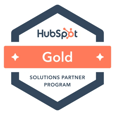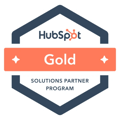Are You Overlooking the Power of Lead Scoring with HubSpot?
Prefer to listen to this post? Press play above!
Not too long ago, I was working with a client, a mid-sized B2B company, who was initially resistant to the idea of setting up lead scoring in HubSpot. They were confident in their traditional methods of lead qualification and didn’t see the need for a complex scoring system. However, their sales team was constantly frustrated, feeling like they were wasting time on leads that weren’t ready to buy.
During one of our meetings, I shared a story about another client who had experienced a similar struggle. They had a lead who had visited nearly every page on their website, watched almost all of their videos, and had actually listened to all their podcast episodes but hadn’t filled out a single form. This lead was essentially invisible to the sales team, as they were focused only on the more obvious interactions.
I shared how HubSpot’s lead scoring system tracks users even before they become known contacts. The moment that anonymous user filled out a form, all their previous activity was recognized, and they immediately received a very high lead score. This wasn’t just about ensuring that the leads the sales team was working on were qualified; it provided a comprehensive insight into the digital body language of potential customers.
This story clicked for our client. They realized that by setting up lead scoring, they could uncover valuable information about their leads’ interests and readiness to buy, even before direct interaction. This revelation transformed their approach. They implemented HubSpot’s lead scoring and quickly saw the benefits. Their sales team was able to prioritize leads more effectively, focusing on those who were genuinely interested and ready to engage, and through contextualized marketing efforts, their messaging was personalized to the prospect with a greater empathetic understanding of their problem and the pain points associated with it.
So, if you're on the fence or just trying to figure out if the juice is worth the squeeze, I'm here to tell you, it is! Now, here's the rest of what you need to know...
Understanding Lead Scoring
Lead scoring is a systematic method used to rank prospects based on their engagement with your brand and their potential value to your business. This scoring system helps sales and marketing teams prioritize their efforts, focusing on leads that are more likely to convert. HubSpot's lead scoring capabilities allow you to assign points to leads based on various factors such as email engagement, website activity, social media interactions, and more.
Lead scoring isn’t just about assigning arbitrary points. It’s about creating a structured approach to identify the most promising leads. This method ensures that your team spends time on prospects who are genuinely interested and likely to become customers, rather than wasting efforts on cold leads. By leveraging HubSpot's advanced analytics and lead tracking features, you can gain a comprehensive understanding of your prospects’ behaviors and preferences.
Why Lead Scoring Matters
- Efficient Resource Allocation: In any business, resources such as time, money, and personnel are limited. Lead scoring enables your team to allocate these resources more efficiently by focusing on high-potential leads. This targeted approach ensures that your sales team spends their time on leads that are most likely to convert, increasing overall productivity and effectiveness.
- Personalized Marketing: Today’s consumers expect personalized experiences. Lead scoring allows you to tailor your marketing efforts to the interests and behaviors of your leads. For example, if a lead consistently interacts with content about a specific product, you can send them more information about that product, creating a more personalized and engaging experience.
- Enhanced Sales and Marketing Alignment: Misalignment between sales and marketing teams is a common challenge. Lead scoring fosters better alignment by creating a clear definition of what constitutes a “qualified lead.” This shared understanding ensures that the most promising leads are given the attention they deserve, enhancing collaboration and improving overall conversion rates.
- Improved Customer Relationships: Building strong relationships with potential customers is key to long-term success. Lead scoring provides insights into your leads’ interests and behaviors, allowing you to engage with them in more meaningful ways. By understanding their needs and preferences, you can provide value at every stage of their journey, building trust and loyalty.
- Optimized Sales Funnel: Lead scoring helps you understand where each lead is in the sales funnel. By tracking and scoring interactions, you can identify leads that are ready to make a purchase versus those that need more nurturing. This insight enables you to deliver the right message at the right time, optimizing the entire sales funnel for better conversion rates.
Making the Most of HubSpot's Lead Scoring
HubSpot's lead scoring feature is both robust and user-friendly, making it accessible for businesses of all sizes. Here are some steps to get started:
- Define Your Ideal Customer Profile (ICP): Start by outlining the characteristics of your ideal customer. Consider factors such as demographic information, company size, industry, and pain points. Your ICP serves as a benchmark for scoring leads and ensures that your efforts are focused on attracting the right audience.
- Identify Key Engagement Metrics: Determine which actions and behaviors indicate a lead's interest and readiness to buy. These could include email opens, click-through rates, website visits, social media interactions, and more. For instance, a lead that visits your pricing page multiple times is likely more interested than one who only opens your emails occasionally.
- Assign Point Values: Assign points to each engagement metric based on its importance. For example, visiting your pricing page might warrant more points than simply opening an email. HubSpot allows you to customize these points based on your unique business needs and goals.
- Set Thresholds for Sales Handoff: Decide on a lead score threshold that indicates when a lead is ready to be passed from marketing to sales. This ensures that sales teams are only spending time on the most qualified leads. Regularly review and adjust these thresholds based on feedback from your sales team to ensure they remain effective.
- Regularly Review and Adjust: Continuously monitor and adjust your lead scoring criteria based on performance and feedback from your sales team. This iterative process will help you refine your approach and improve results over time. Use HubSpot’s analytics to track the success of your lead scoring model and make data-driven adjustments.
- Leverage Automation: Use HubSpot’s automation tools to streamline the lead scoring process. Automated workflows can help you assign scores, send personalized follow-up emails, and alert your sales team when a lead reaches a certain score. This automation ensures that no lead falls through the cracks and that your team can respond promptly to high-scoring leads.
Success Stories: The Impact of Lead Scoring
Many businesses have transformed their sales and marketing efforts by implementing lead scoring in HubSpot. For example, a mid-sized B2B company we work with here at Sauce saw a 30% increase in conversion rates after implementing a lead scoring system. By focusing their efforts on high-scoring leads, they were able to close deals more efficiently and boost their revenue.
Another example is a consulting agency that worked with Sauce to use HubSpot’s lead scoring to refine its lead nurturing process. By identifying and targeting high-potential leads, they increased their client base by 20% in just six months. These success stories highlight the transformative power of lead scoring in driving business growth.
Common Challenges and Solutions
While lead scoring is highly effective, it’s not without its challenges. Some common obstacles include:
- Data Quality: Inaccurate or incomplete data can skew lead scores. Ensure your CRM data is clean and up-to-date by regularly auditing your database.
- Scoring Accuracy: Over time, the effectiveness of your scoring criteria may diminish. Regularly review and update your scoring model to reflect changing customer behaviors and market conditions.
- Cross-Department Collaboration: Effective lead scoring requires collaboration between sales and marketing teams. Encourage regular communication and feedback to ensure both teams are aligned and working towards common goals.
Conclusion
In a world where customer experience is paramount, overlooking the power of lead scoring with HubSpot could mean missing out on valuable opportunities to create moments that matter. By implementing a strategic lead scoring system, you can enhance your marketing efforts, align your sales and marketing teams, and ultimately build stronger, more meaningful relationships with your leads.
Don’t let these opportunities slip through your fingers. Start leveraging the power of lead scoring with HubSpot today and watch your business thrive. By integrating lead scoring into your strategy, you're not just optimizing your sales process—you're creating a pathway to meaningful customer interactions that drive growth and success.
Ready to get started? HubSpot makes it easy to turn your leads into loyal customers, one score at a time. Book a connect call with a certified Growth Guide to embrace the power of lead scoring and unlock the full potential of your sales and marketing efforts. Your business, your team, and your customers will thank you.
.webp?width=12693&height=4513&name=Sauce%20Logo%20Dark%20Ht%20(1).webp)

.webp?width=180&height=64&name=Sauce%20Logo%20Dark%20Ht%20(1).webp)











